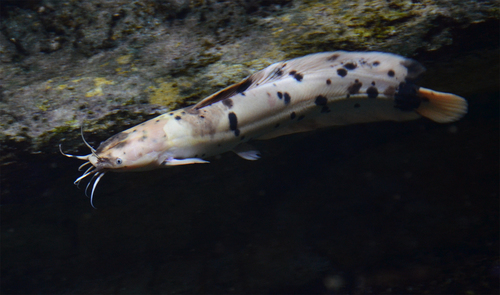
Walking Catfish
The Atlantic bluefin tuna (Thunnus thynnus) is a highly migratory, large pelagic fish renowned for its size, speed, and commercial value. It plays a crucial role in the marine ecosystem and is a prized catch in fisheries worldwide, especially for sushi.
3 8 years
Lifespan
25 - 50 cm
Length
Least Concern
Conservation Status
5 km/h
Swimming speed
Omnivorous, Insectivorous
Diet
Local Migration
Migration
Appearance Overview
The Atlantic bluefin tuna is a large, torpedo-shaped fish with a metallic blue-black back and a silvery-white belly.
Color
Dark metallic blue on top, silvery-white underside
Body shape
Torpedo-shaped, streamlined
Fins
Two dorsal fins, the first depressible; small finlets behind dorsal and anal fins
Keel
Strong lateral keel on the caudal peduncle
Length
Up to 13 feet (4 meters), commonly 6.5 feet (2 meters)
Weight
Up to 2,000 lbs (900 kg), commonly 550 lbs (250 kg)
Diet
Carnivorous, feeding on a variety of fish (such as herring, mackerel, and hake), squid, and crustaceans.
Feeding Behavior
Highly active predator, uses speed and agility to chase down prey. They can also filter-feed on smaller organisms.
Social Behavior
Forms large schools, especially during spawning season. Schools may be segregated by size. Exhibits migratory behavior.
Commercial Relevance
Extremely high value, particularly in the sushi and sashimi markets of Japan. One of the most expensive fish in the world.
Conservation measures
International fishing quotas, minimum size limits, and seasonal closures. Efforts to reduce bycatch and improve fishing practices are ongoing.
Status
Endangered (IUCN)
Threats
Severe overfishing driven by high demand, particularly for sushi. Bycatch in other fisheries, and potentially climate change affecting prey distribution.
Habitat Distribution
Depth Range
0-1,000 meters (0-3,280 feet), but most commonly found in the upper 200 meters.
Geographic Range
Western and Eastern Atlantic Ocean, including the Mediterranean Sea. Historically also in the Black Sea.
Preferred Environment
Temperate and subtropical waters; open ocean (pelagic) and coastal areas.
Reproduction and Life Cycle
Breeding Habits
Spawns in warm waters, with two main spawning grounds: the Mediterranean Sea and the Gulf of Mexico. Spawning typically occurs in spring and summer.
Development Stages
Eggs hatch into larvae, which feed and grow rapidly. Juveniles develop into adults over several years, undergoing significant physiological changes.
Fecundity
Highly fecund; a large female can produce up to 30 million eggs per spawning season.
Maturity Age
Reaches sexual maturity at approximately 4-8 years of age, depending on location and conditions.
Faqs about Walking Catfish
Where can Atlantic bluefin tuna be found?
Atlantic bluefin tuna are found in the Atlantic Ocean, both in the western and eastern parts, and also in the Mediterranean Sea.
How long do Atlantic bluefin tuna live?
Atlantic bluefin tuna can live for up to 40 years, although this is becoming increasingly rare due to overfishing.
How fast can Atlantic bluefin tuna swim?
They are among the fastest fish in the ocean, capable of bursts of speed up to 43 mph (70 km/h).
Are Atlantic bluefin tuna warm-blooded?
Yes, they are warm-blooded, which allows them to maintain a higher body temperature than the surrounding water, giving them advantages in speed and endurance.
How many eggs can a female bluefin tuna lay?
Females can release millions of eggs per spawning season, up to 30 million, depending on their size and condition.
When do bluefin tuna reach maturity?
They reach sexual maturity at around 4-8 years of age, though this can vary depending on the population and environmental conditions.
What is the role of Bluefin tuna in their Ecosystem?
Bluefin tuna are at the top of the food chain and help regulate the populations of their prey, maintaining balance in the marine ecosystem.
How far do Bluefin tuna migrate?
Bluefin tuna undertake extensive migrations across the Atlantic Ocean for feeding and spawning, covering thousands of miles.
Copyright @ Nature Style Limited. All Rights Reserved.
 English
English